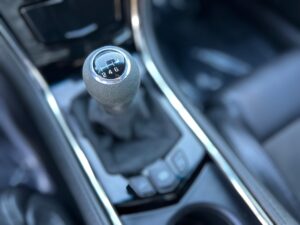Manual gearboxes…please say more.
Remember when driving a car meant feeling the clutch bite, shifting at redline, rev-matching on the downshift?
When a manual wasn’t just an option — it was everything? Sedans, hatchbacks, even trucks came with stick shifts.
Over time, that faded. Automatics, CVTs, and now electrics made things “easier,” “smoother,” “more efficient.” Manuals all but vanished from mainstream issuers.
But lately… there’s been a murmur. A rumble from gearheads. Manuals are slowly pushing back.
What The Data’s Saying
CarMax reports manual-equipped used car sales at ~2.9% most recently. Up from ~2.4% in 2020.
Also worth noting: vehicles known for performance or niche appeal (sports, hot hatches, enthusiast sedans) are disproportionately carrying manual options.
Manuals aren’t coming back in minivans; they’re surviving among brands and models that can afford to give driving back to the driver.
Nostalgia, But Real Nostalgia
What’s fueling this shift? It’s more than just wanting to “go back to the good old days.”
Here’s what people are saying:
-
Connection. Manuals make you part of the car. You’re not just along for the ride; you’re driving. Clutch, shift, rev — it’s physical and emotional.
-
Identity. There’s street cred. Manual owners talk. It’s something to brag about. Especially when so few cars offer them.
-
Rebellion. In a world of pads, touchscreens, EV modes, and automation — choosing a stick is saying, “Nope. I want this. I choose engagement.”
-
Younger generations (Millennials, Gen Z) are getting in on this. They like analog experiences (vinyl, film cameras, manual coffee grinders); the stick shift fits right into that vibe.
Why Manual Gearboxes Feel Like Home
There’s a reason the manual has this pull:
-
It’s unpredictable. A little bit messy. You stall once in a while. But that’s part of the charm.
-
It forces you to pay attention — revs, gears, timing. You feel the road in ways automatics often mute.
-
It’s therapy. Driving stick in traffic might be a chore, but on a winding road? It’s meditation. And when you engage the car like that, memories happen — first car, dad teaching you, back roads, summer nights.
For many, it isn’t nostalgia for nostalgia’s sake — it’s a reclaiming of something lost.
FAQs
1. Is buying used cars with manual gearboxes harder now?
Yes — sourcing a stick-shift model trims your options. But it also means the ones you do find are more cherished, better kept, and often carry a premium.
2. Are manuals still supported by manufacturers, or will they disappear soon?
Manufacturers are keeping them in select, enthusiast-focused trims. Not every model. Manual options are rare, but where they exist, they tend to stay (if demand holds). If customers keep asking, some automakers have said they’ll listen.
3. Do manuals cost more to maintain?
Not inherently. The clutch will wear eventually, but modern manuals are pretty durable. Maintenance cost depends more on vehicle make, model, use (track vs. gentle driving). of course, parts and labor matter. For the serious driver, shifting your own often pays back in driving satisfaction.
Final Thoughts: Let Your Hands Drive You
If you grew up learning to sync the revs, driving stick felt like mastery — or if you’ve always wanted to but only had auto options — this rise in manuals is your invitation.
Check out our inventory of pre-owned cars and make sure you check out our manual models.




